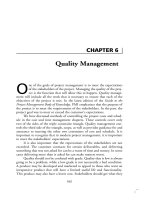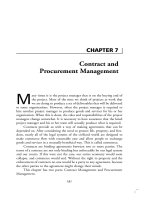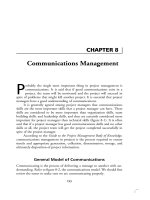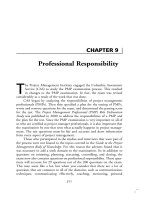Tài liệu Project Management Professional-Chapter 12a (Question) docx
Bạn đang xem bản rút gọn của tài liệu. Xem và tải ngay bản đầy đủ của tài liệu tại đây (104.75 KB, 11 trang )
TIME MANAGEMENT
The following information and questions 1 through 10 refer to figure 1.
A schedule was developed for a project to install windows in an apartment
building. The project is a rush job, and the contractor has agreed to schedule
the work on a single shift basis but will work seven days per week until the
job is done. The project is to begin on May 1.
Figure 1. Scheduling Practice Exercise.
A
1
C
3
G
4
Act #
DURATION
B
3
D
2
F
4
FS-2
E
7
H
5
1. What day in May will activity D have for its early finish date?
a. May 13
b. May 6
c. May 7
d. May 5
244
245Time Management
2. What is the free float for activity F?
a. 6
b. 7
c. 0
d. 8
3. What is the free float for activity D?
a. 6
b. 7
c. 8
d. 0
4. What is the critical path of the project?
a. A B E G H
b. A B D F H
c. A C G H
d. ABEDFH
5. What is the late start for activity F?
a. May 10
b. May 11
c. May 12
d. May 14
6. How long is the project in days?
a. Nineteen
b. Twenty
c. Twenty-one
d. Eighteen
7. What is the early start for activity F?
a. May 7
b. May 6
c. May 5
d. May 4
9618$$ CH12 09-06-02 15:00:16 PS
246 Preparing for the Project Management Professional Certification Exam
8. If there is a delay in activity F of six days, what is the effect on the
project completion date?
a. Increases one day
b. No change to project completion date
c. Increases two days
d. Increases three days
9. What is the early finish date of activity A?
a. May 1
b. May 2
c. May 3
d. May 4
10. The above diagram is called:
a. Activity on arrow network diagram.
b. Network diagram.
c. Precedence diagram.
d. Gantt chart.
11. If a project manager were to make Thanksgiving dinner, two of the
activities that might be of concern would be roasting the turkey and
baking the sweet potatoes. In order to ensure that these two items will
be finished cooking and will come out of the oven at the same time,
what type of relationship should he or she use in the schedule between
these two activities?
a. Finish-finish
b. Start-start
c. Finish-start
d. Start-finish
Questions 12 through 15 refer to the diagram in figure 2 and the table that
follows.
In a project to install concrete sewer lines there is a lot of uncertainty as to
how long the durations should be for the tasks involved. The project man-
ager has determined that the team will use the PERT technique to evaluate
the project’s completion date. The diagram shows nine activities and the
9618$$ CH12 09-06-02 15:00:17 PS
247Time Management
table shows the optimistic, pessimistic, and most likely estimates that the
team has already made.
Figure 2. PERT Diagram.
A
C
H
E
Act #
B D GF
I
Most
Activity Optimistic Pessimistic Likely
A1 11
B2 33
C10 1312
D5 55
E3 64
F1 11
G5 86
H 9 13 10
I5 55
12. What is the expected value of the number of days to complete the
project?
a. 47.3
b. 22.0
9618$$ CH12 09-06-02 15:00:18 PS
248 Preparing for the Project Management Professional Certification Exam
c. 32.3
d. 48
13. It is desirable to make an estimate that has a greater than 95% chance
of being correct. Which of the following ranges of time for the comple-
tion of the project best describes this probability of being correct?
a. 33.31 to 31.36
b. 34.28 to 30.39
c. 14.39 to 33.48
d. 35.25 to 29.42
14. What is the expected value of the duration for activity B?
a. 5.6
b. 2.8
c. 3.0
d. 2.6
15. What is the standard deviation for the duration of activity B?
a. 1.000
b. .133
c. .166
d. 1.413
16. The project manager decided to improve the predicted completion date
for the project by doing in parallel several of the activities that were
scheduled to be done in sequence. This is called:
a. Crashing.
b. Increasing priorities.
c. Hurry up defense.
d. Fast tracking.
17. Crashing the schedule means:
a. Making the project shorter by any economic means.
b. Running the project team on overtime.
c. Doing activities that were in sequence in parallel.
d. Getting out of town before the project is in trouble.
9618$$ CH12 09-06-02 15:00:19 PS
249Time Management
18. The original schedule (for a project, a work package, or an activity),
plus or minus approved changes, is called:
a. The working schedule.
b. The target schedule.
c. The performance schedule.
d. The baseline schedule.
19. Schedules are used in many ways. In a project to build a bridge the
project manager wants to use a tool that will show the scheduled activi-
ties in such a way that it is easy to see when each activity starts and
finishes and which activities are taking place at the same time. Which
tool should be used?
a. PERT chart
b. Gantt chart
c. Precedence diagram
d. GERT chart
20. Which of the following is true?
a. The critical path is the path through the network that has the high-
est total duration.
b. The critical path is the path with the least amount of free float.
c. The critical path is the list of activities that have zero float.
d. The critical path is the list of activities that have critical risks associ-
ated with them.
21. Resource leveling will generally:
a. Reduce the time needed to do the project.
b. Increase the total time necessary to do all the tasks.
c. Reduce the overutilization of resources.
d. Reduce resources to the lowest skill that is possible.
22. A task was scheduled to use two persons, full time, and take two weeks
to complete. Instead, the project manager was only able to assign one
person to this task. At the end of two weeks, the person assigned to the
task was 75% complete. What is the cost performance index?
a. .75
b. 1.5
9618$$ CH12 09-06-02 15:00:19 PS
250 Preparing for the Project Management Professional Certification Exam
c. 1.33
d. .5
23. Five tasks are scheduled to be completed in sequence. Each task has a
finish-start relationship with the next task. Each has one day of total
float. As of today, task one and two have been completed on schedule.
How many days of float remain in the schedule for these tasks?
a. Two
b. One
c. Zero
d. Four
24. Which of the following is considered to be a simulation technique?
a. PERT analysis
b. GERT analysis
c. Monte Carlo analysis
d. Critical path method
25. The main difference between the two types (ADM, arrow diagramming
method, and PDM, precedence diagramming method) of the critical
path method (CPM) of scheduling is:
a. Placement of the activity on the logic diagram line.
b. Arrow diagramming method (ADM) is a deterministic method,
whereas the precedence diagramming method (PDM) is a probabi-
listic method.
c. Precedence diagramming method (PDM) is a deterministic method,
whereas the arrow diagramming method (ADM) is a probabilistic
method.
d. Precedence diagramming method (PDM) is a more accurate
method.
26. The project schedule is not used to determine:
a. The start and finish dates of the activities.
b. Occasional changes to the activity listing.
c. The total float of the activities.
d. The project’s budget.
9618$$ CH12 09-06-02 15:00:20 PS
251Time Management
27. The overall duration of the project schedule is not influenced by:
a. Using mandatory dependencies as constraints.
b. Using discretionary dependencies as constraints.
c. The availability of the resources that are assigned to perform the
work.
d. Using the arrow diagramming method instead of the precedence
diagramming method (PDM) of scheduling.
28. The program evaluation and review technique (PERT) method of
scheduling differs from the critical path method (CPM) because the
PERT method:
a. Uses weighted averages of activity durations to calculate project du-
ration.
b. Uses ‘‘dummy’’ activities to represent logic ties.
c. Uses ‘‘free float’’ instead of ‘‘total float’’ in the schedule calculations.
d. Uses bar charts instead of logic diagrams to portray the schedule.
29. A project manager is managing a project and is considering the resched-
ule of an activity because one of the project engineers must work on
this activity and another activity at the same time. Each of the activities
is scheduled to have a duration of two weeks. One of the activities is on
the critical path and the other activity has eighteen days of free float.
The project manager should:
a. Reschedule the activity that has no float.
b. Reschedule the activity with float.
c. Ask the engineer to work overtime.
d. Reschedule both activities to take advantage of the float on each.
30. A project manager looks at her schedule and sees that there has been a
delay in completing a task. It seems practical to move a person from
another task that is an expert on the work that is behind. There is a
choice of using two different persons that are working on two different
tasks. One person is working on a task that has five days of free float
and the other is working on a task that has eight days of total float and
no free float. Which person should be used to help out?
a. The person working on the task with free float of five days.
b. The person working on the task with total float of eight days.
9618$$ CH12 09-06-02 15:00:21 PS
252 Preparing for the Project Management Professional Certification Exam
c. Either person can be used.
d. A person should be brought in from outside the project.
31. In the first attempt in resource leveling the project schedule, what would
you expect to occur?
a. The number of required resources will increase during certain time
periods of the project.
b. The number of required resources will decrease during certain time
periods of the project.
c. The overall project duration will increase.
d. The overall project duration will decrease.
32. According to the Guide to the PMBOK, work packages can be divided
into:
a. Smaller work packages.
b. Tasks.
c. Activities.
d. Subprojects.
33. A project is nearly 33% complete according to the earned value report-
ing method. An identified risk has occurred, and the project manager
has chosen to draw funds from the contingency fund and add the activi-
ties necessary to deal with the problems associated with the risk. What
should he do next?
a. The schedule should not be changed. Original plans should have
allowed for this delay.
b. The budget money set aside for the risk should be released, but there
is not a need for a schedule change.
c. The schedule and budget baselines should be changed, to show the
new work.
d. The budget baseline should be changed, but the work should be
done within the schedule as it is.
34. The key inputs to activity definition are:
a. Work breakdown structure, the project schedule, and the network
diagram.
b. Project schedule, progress reports, and change requests.
9618$$ CH12 09-06-02 15:00:21 PS
TEAMFLY
Team-Fly
®
253Time Management
c. The project network diagram, constraints, and durations.
d. The work breakdown structure, the scope statement, and historical
information that supports the applicable activity.
35. A project manager is approached by the major stakeholder in the project
and is asked to reduce the time for the scheduled completion of the
project. The project manager reviews the project plans and the progress
that has been made on the project. He or she decides that the best
approach to solving this problem is to fast track the project until the
new project completion date can be achieved. Which of the following
will be done by the project manager?
a. Reduce the project schedule by any means that are possible
b. Reduce the project schedule by applying any practical means neces-
sary
c. Reschedule activities that would be done in sequence to activities
that can be done in parallel
d. Inform the stakeholder that this will change the project schedule
and will require additional funds to comply with the request
36. A project manager would like to manage his project in such a way that
he will be able to identify specific tasks that should be watched and
managed more closely than others. The project manager should use
which method?
a. The PERT method
b. The critical path method
c. The GERT method
d. The PCDM method
37. A project manager would like to manage his project in such a way that
he will be able to predict more accurately the duration of the project
even though the estimates for the duration of the activities have a lot
of variability. The project manager should use which method to more
accurately predict the project completion date?
a. CPM
b. GERT
c. PERT
d. Activity sampling
9618$$ CH12 09-06-02 15:00:22 PS
254 Preparing for the Project Management Professional Certification Exam
38. The project manager for a project is going to use the PERT method of
scheduling for the project that she is working on. Using the PERT
calculation the variance for the project is found to be 25 days and the
duration of the project is found to be 169 days. What is the range of
values for the project duration such that there will be at least a 95%
probability that the actual project completion will fall between the high
and low value of the range of values?
a. 164–173 days
b. 144–194 days
c. 119–219 days
d. 159–179 days
39. In distinguishing PERT from CPM one could say that:
a. PERT is probabilistic and CPM is deterministic.
b. CPM is probabilistic and PERT is deterministic.
c. Either one is deterministic or probabilistic depending on how they
are used.
d. Neither one is deterministic or probabilistic.
40. According to the Guide to the PMBOK the lowest level of the work
breakdown structure is:
a. The task.
b. The activity.
c. The work package.
d. The element.
9618$$ CH12 09-06-02 15:00:22 PS









